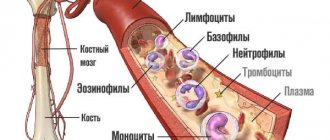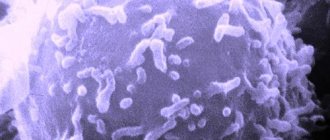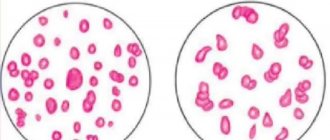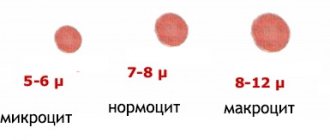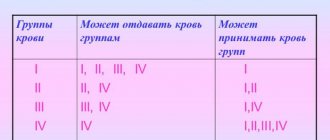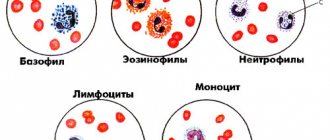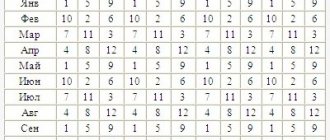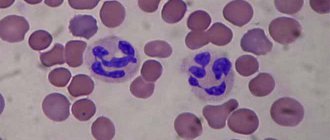What is it prescribed for?
The number of blood cells can change as a result of pathological and physiological processes in the body, therefore a general blood test is the most informative indicator of health and is prescribed for:
- determining the diagnosis (inflammatory or purulent process, anemia, tumors);
- assessing the functional state of the immune and hematopoietic system, as well as the body’s response to infection;
- definition of complications;
- assessing the severity of acute and the presence of chronic disease;
- monitoring the effectiveness of treatment;
- prognosis of disease development and recovery.
Preparing for analysis
To eliminate errors in the results of the general analysis, before taking blood from a finger, you must adhere to simple rules:
- donate blood on an empty stomach in the morning;
- the day before the test, avoid the consumption of fatty foods, alcoholic beverages, and high physical activity;
- 2 hours in advance do not smoke, drink tea or coffee;
- ensure a calm state of the body in 15-20 minutes (exclude running, fast walking, climbing stairs).
If on the day of the general analysis other procedures are prescribed, for example, x-rays, ultrasound, colonoscopy, gastroscopy, massage, then blood sampling should be carried out first to prevent distortion of the indicators.
Norms of general blood test in adults (table)
The table contains the main indicators of general clinical analysis, which display the quantity, as well as the physical properties of blood cells (leukocytes, erythrocytes and platelets).
| Normal for women | Normal for men |
| Red blood cells (Er, EBC), *10^12/l | |
| 3,7 — 4,7 | 4,0 – 5,1 |
| Hemoglobin (Hb), g/l | |
| 120-140 | 130-160 |
| Color index (MCH), % | |
| 0,86-1,05 | 0,86-1,05 |
| Reticulocytes (RTC), % | |
| 0.2-1.2 | 0.2-1.2 |
| Erythrocyte sedimentation rate (ESR), mm/h | |
| 2-15 | 1-10 |
| Hematocrit (HCT), % | |
| 36-42 | 40-48 |
| Platelets (PLT), *10^9/l | |
| 180-320 | 180-320 |
The normal indicators for the leukocyte formula, which are included in the general blood test, do not depend on gender and age, and include the total level of leukocytes and individual types of white blood cells (neutrophils, eosinophils, basophils, monocytes and lymphocytes).
| Norm, *10^9/l | Ratio, % |
| White blood cells (WBC) | |
| 4,0-8,8 | |
| Band neutrophils (NEUT) | |
| 0,04-0,300 | 1-6 |
| Neutrophils segmented (NEUT) | |
| 2,0-5,5 | 45-70 |
| Eosinophils (EOS) | |
| 0,02-0,3 | 0-5 |
| Lymphocytes (LYM) | |
| 1,2-3,0 | 18-40 |
| Monocytes (MON) | |
| 0,09-0,6 | 2-9 |
Decoding abbreviations
The meaning of WBC in a general blood test is white blood cells, which translated from English means white blood cells. This is how a blood test identifies leukocytes, which under a microscope look like white cells. The unit of measurement is 10 9 /l.
The meaning of RBC in a blood test is red blood cells. In laboratory analysis, red blood cells are designated as such. Unit of measurement - 10 12 /l
HGB is a shortened version of the English word Hemoglobin. This is how hemoglobin is indicated on the blood test printout. Unit of measurement - g/l (g/l), g/dl (g/dl).
HCT stands for Hematocrit.
Interpretation of a general blood test
When deciphering the results of a clinical blood test to assess the state of health or diagnose a disease, not only the increase or decrease of specific indicators relative to the norm is taken into account, but also the general composition, as well as the ratio of the formed elements relative to each other.
Red blood cells
Erythrocytes are red blood cells that participate in the exchange of oxygen and carbon dioxide, in blood clotting, in the ionic and acid balance of plasma, and also bind toxins and transport antibodies. An increase in the number of red blood cells (erythrocytosis) develops when:
A reduced content of red blood cells in the blood (erythrocytopenia) is observed as a result of the physiological characteristics of the body in women, the elderly, and athletes. Among the pathological causes of erythrocytopenia are:
- leukemia;
- hypoplastic or aplastic anemia;
- hemolytic, iron deficiency, B-12 deficiency anemia;
- bone marrow dysfunction;
- blood loss
Hemoglobin
Red blood cells contain hemoglobin, an iron-containing protein, the main functions of which are the attachment of oxygen molecules for transport from the lungs to cells and carbon dioxide for removal from the body, as well as the regulation of acid-base balance.
Elevated hemoglobin is rare and indicates the possible development of heart failure, and is also observed with dehydration and blood thickening.
A decrease in hemoglobin levels in adults occurs when using medications (painkillers, antibiotics, anticonvulsants, antitumor drugs) or in the presence of the following pathologies:
- anemia;
- bleeding (acute or hidden);
- malignant tumors (including those with metastases).
Color index
The ratio of the number of red blood cells and hemoglobin in a general analysis is called the blood color index and indicates the degree of saturation of red blood cells with iron-containing protein. CP increases with iron deficiency anemia, and decreases as a result of the development of megaloblastic anemia.
Reticulocytes
Reticulocytes are young immature red blood cells that circulate in the blood for 1.5-2 days, gradually maturing and turning into full-fledged red blood cells. A normal number of reticulocytes in the results of a general blood test indicates proper erythropoiesis - the formation of red blood cells by the bone marrow.
If the level of reticulocytes is elevated, this may indicate anemia (iron deficiency, megaloblastic, hypo- and aplastic) or be a consequence of treatment with cytostatics (antitumor drugs).
The reasons for the decrease in the number of reticulocytes in the blood are such pathological processes as:
- bleeding (with ulcers, tumors);
- damage to the bone marrow by cancer metastases;
- radiation sickness.
Erythrocyte sedimentation rate
Analysis of ESR is carried out by measuring the speed at which red blood cells stick together into fractions and sink to the bottom of the tube, displaying the presence and intensity of the inflammatory process.
An increased level of ESR in an adult develops due to natural reasons, such as fasting, dehydration, menstrual periods and pregnancy, as well as due to a number of diseases:
- infectious and inflammatory diseases;
- purulent inflammation and sepsis;
- blood diseases (anemia, hemoblastosis);
- autoimmune disorders;
- tumors.
Low ESR can be the result of a violation of the water-salt balance in the body, prolonged fasting, pregnancy, as well as with:
- hepatitis;
- leukocytosis;
- heart failure;
- epilepsy;
- neurosis;
- anaphylactic shock.
Hematocrit
Hematocrit is the percentage of all formed elements to plasma volume, which shows the degree of blood viscosity. If a clinical blood test indicates an increase in hematocrit, this may indicate the presence of:
- chronic lung diseases;
- polycystic kidney disease or hydronephrosis;
- different forms of leukemia;
- diabetes mellitus;
- poisoning accompanied by dehydration, vomiting and diarrhea.
The most common causes of low hematocrit are:
- pathologies of the hematopoietic system (hemoblastosis);
- chronic inflammation (cystitis, glomerulonephritis, pyelonephritis, polycystic disease, viral hepatitis);
- cardiovascular diseases (thrombosis, atherosclerosis).
Platelets
Platelets are anucleate blood cells involved in the formation of a platelet clot (to stop bleeding), in the regulation of the local inflammatory response and in other processes associated with the elimination of damage to blood vessels and capillaries.
An increase in platelet levels is observed during treatment with corticosteroids, after surgery and bleeding, and also indicates:
- chronic inflammation;
- myeloproliferative disorder (myelofibrosis, erythema);
- malignant neoplasms (cancer, lymphogranulomatosis, lymphoma);
- hemolytic anemia.
A decrease in platelets occurs in many hereditary and acquired diseases, namely:
- thrombocytopenia (congenital, Wiskott-Aldrich syndrome, histiocytosis, Fanconi syndrome);
- hemolytic disorders (leukemia, aplastic or megaloblastic anemia);
- diseases of the thyroid gland (hypothyroidism, hyperthyroidism);
- bone marrow pathologies (bone tuberculosis, cancer metastases);
- infectious lesions (viral, bacterial, toxoplasmosis, malaria, HIV).
Leukocytes
Leukocytes are white blood cells whose main role is to protect against viral, bacterial and fungal infections, form antibodies, stimulate tissue regeneration, block and eliminate toxins.
The leukocyte formula in a general blood test displays the percentage of all types of leukocytes, and can change, shifting to the right or left, in the presence of pathological processes in the body.
Leukocytosis is an increased content of leukocytes in the blood, which can develop as a result of natural or pathological causes:
- pregnancy;
- PMS;
- heart attack;
- thrombosis of peripheral arteries;
- cholecystitis, pancreatitis;
- appendicitis;
- bronchitis, pneumonia, asthma;
- pyelonephritis;
- leukemia;
- burns or injuries;
- bleeding.
A lack of white blood cells is a dangerous sign of decreased production or rapid destruction of white blood cells due to the development of diseases such as:
- aplasia, hypoaplasia;
- HIV infection;
- tuberculosis;
- Epstein-Barr virus;
- acute and long-term deficiency of B vitamins.
Neutrophils (band, segmented)
Neutrophils or neutrophil granulocytes actively participate in the immune response to diseases of a bacterial and viral nature, providing phagocytosis - the absorption and neutralization of foreign microorganisms.
The transcript of the analysis results shows the indicators for band (immature) and segmented (mature) neutrophils, which occupy from 40 to 70% of all leukocytes in the blood.
The level of neutrophils increases in the case of pathologies leading to overactive bone marrow, which causes an increase in the production of immature forms of cells (maturing in 18-24 hours), for example:
- bacterial infection;
- inflammation accompanied by the formation of pus (pneumonia, phlegmon, abscess, appendicitis);
- tissue necrosis during myocardial, kidney, lung or spleen infarction, as well as during the development of diabetic coma;
- bleeding.
Neutropenia or a decrease in the concentration of neutrophils in the blood is observed in infectious and viral diseases such as influenza, chicken pox, measles, malaria, rubella, polio, hepatitis, as well as in tuberculosis, acute sepsis and vitamin B12 deficiency.
Eosinophils
The main functions of eosinophils are the ability to capture and neutralize foreign microorganisms (including destroying helminthic infections), provide an anti-inflammatory effect, and also reduce the allergic reaction.
The following pathologies are identified that can increase the level of eosinophils (eosinophilia) in the blood:
- disorder of the hematopoietic system (myeloid leukemia, lymphogranulomatosis, polycythemia, leukemia);
- diseases accompanied by allergies (dermatitis, eczema, bronchial asthma, hay fever, drug intolerance);
- helminthic infections;
- tumors;
- connective tissue disorders (rheumatoid arthritis, polyarthritis nodosa).
Eosinophil deficiency develops with a lack of vitamin B-12, inflammation of the pancreas, and poisoning with heavy metal salts (mercury, lead, arsenic).
Basophils
Basophils produce histamine, which contributes to the development of immediate and delayed allergies, participates in the body’s inflammatory reactions, prevents blood clotting and regulates the permeability of vascular walls.
Due to the low reference value, it is impossible to determine low basophil levels using a blood test. In cases where the number of basophils is increased, this indicates:
- allergic reaction regardless of the type of allergen (food, medications);
- chronic ulcerative colitis;
- hypothyroidism;
- lymphogranulomatosis;
- myeloid leukemia, myelofibrosis.
Lymphocytes
Lymphocytes are regulators of the immune system, as they are able to recognize foreign cells and control the activity of other leukocytes involved in the body's immune response to fight infection.
An increased content of lymphocytes is characteristic of the development of cancer (lymphocytic leukemia, lymphosarcoma), as well as certain types of infections:
- viral (influenza, acute viral hepatitis, adenovirus, infectious mononucleosis);
- bacterial (tuberculosis, diphtheria, brucellosis, syphilis, malaria);
- toxoplasmosis.
In cases where the analysis shows a reduced level of lymphocytes, this indicates the presence of malignant neoplasms in the lymph nodes, HIV infection or the development of tuberculosis, which cause a disruption in the formation of immune cells.
Monocytes
Monocytes produce antibodies (to destroy foreign proteins) and cytotoxins aimed at combating tumor, old and atypical cells of the body, and also carry out phagocytosis (not only in the blood, but also in tissues). Monocytes also participate in the processes of hematopoiesis, carbohydrate metabolism and restoration when the integrity of blood vessels is damaged.
A high level of monocytes in the blood is called monocytosis and is characteristic of diseases accompanied by the presence of a large number of foreign and destroyed cells, for example:
- leukemia, myeloid leukemia;
- lymphogranulomatosis;
- Infectious mononucleosis;
- infections (protozoal, viral and extensive fungal);
- tuberculosis;
- syphilis;
- brucellosis;
- ulcerative colitis;
- rheumatoid arthritis.
Among the reasons for a decrease in the number of monocytes in the blood are depletion of the hematopoietic system as a result of anemia, sepsis, ionizing radiation or chemical poisoning, as well as long-term treatment with glucocorticosteroid drugs.
UAC parameters
When diagnosing diseases of various natures, the doctor must prescribe a CBC, which includes the characteristics of blood cells.
Such a detailed analysis is called clinical, and it includes, in addition to the characteristics of red blood cells and platelets, a report on the quantitative and qualitative composition of all five groups of leukocytes contained in the blood.
Each of the 5 types of leukocytes is designated by its own abbreviation, which is formed from the first letters of the Latin name.
White blood cells WBC - from English. White Blood Cells, in a blood test, are divided into subgroups:
- neutrophils – NEU:
- lymphocytes - LYM;
- eosinophils - EOS;
- basophils - BAS;
- monocytes - MON.
The # and % signs that appear next to the letter designation indicate:
- # is the absolute number of cells;
- % is a relative value showing the percentage of the subgroup to the number of total leukocytes.
A test that counts all WBC components and red blood cell characteristics is ordered when a more complete blood report than the CBC is required for diagnosis.
WBC blood test rates for adult men and women do not differ based on gender, which distinguishes white blood cells from red blood cells, as can be seen in the table below. The characteristics of red blood cells are different in women and men.
The GR parameter shows the absolute numerical or relative (percentage) number of granulocytes in the blood plasma.
Granulocytes are defined as neutrophils, eosinophils and basophils, the cytoplasm of which contains granules that can be stained with basic or acidic dyes.
Among the leukocyte parameters in the CBC forms, the abbreviation IMM is found, which reflects the number of immature forms of granulocytes.
Lymphocytes and monocytes are combined in the WBC blood test into the group of agranulocytes. Another additional parameter of agranulocytes in CBC is atypical lymphocytes (ATL).
Atypical lymphocytes include cells that differ in shape and internal structure from the lymphocytes of a healthy person. The appearance of ATL in small quantities does not pose a threat to health, since defective lymphocytes are normally recognized and destroyed by the immune system.
The ATL indicator has no diagnostic value in the general analysis, and is rarely included in it; you should not be alarmed when you see that there are atypical lymphocytes in the blood.
Mandatory parameters in diagnosis are designations that characterize various properties of red blood cells. In addition to the number of red blood cells, which is indicated by the sign RBC, commonly used abbreviations include:
- HGB, HB - hemoglobin:
- HCT – hematocrit;
- RET - reticulocytes;
- color index;
- MCHC, MCH, MCV - characteristics of the average volume, hemoglobin content and saturation of an erythrocyte with hemoglobin, which is described in detail on individual pages of the site.
Reticulocytes are the immature forms of red blood cells that constantly flow from the bone marrow into the bloodstream, where they mature and replace the mature forms of red blood cells. Normal RET levels in the bloodstream range from 0.2% to 1.2%.
An increase in reticulocytes in the CBC analysis indicates a lack of oxygen in the tissues, the destruction of red blood cells in hemolytic anemia. A decrease in RET is observed in anemia caused by deficiency of B9, B12, and lack of iron.
The normal color index for women and men is 0.86 – 1.05. This value reflects the amount of hemoglobin in a red blood cell and in its value corresponds to the more modern MCH parameter.
A designation such as HCT in a blood test means hematocrit - this is the ratio of all formed elements, which practically corresponds to the number of red blood cells, to the volume of plasma.
And since 99% of all formed elements are erythrocytes, an increase or decrease in hematocrit is determined by a change in the number of erythrocytes.
In deciphering blood tests in women during pregnancy, there is often a deviation from the norm caused by a decrease in the % HCT indicator due to an increase in total fluid in the body.
Along with the RBC indicators, which are described on other pages of the site, along with the leukocyte formula, abbreviations for platelet parameters (PLT) are often indicated.
In the deciphering of the blood test, there is a characteristic of the general indicator of platelets in the total volume of blood PCT or thrombocrit. Normally, PCT in adult women and men does not exceed 0.28%.
When making a diagnosis, two more PLT indicators are used:
- P - LCR - measured in %, shows how the volume of large platelets relates to the volume of all platelets;
- P - LCC - changes to 109/l, the parameter shows how many large platelets are in the bloodstream.
P – LCR and P – LCC are interconnected. To obtain the number of large platelets in the blood P - LCC, you need to multiply the total number of PCT platelets by P - LCR.
The above measurements and calculations are necessary when diagnosing heart disease. An increase in P-LCR in tests indicates that the phenomenon of thrombus formation in the blood is increasing, and this greatly increases the risk of myocardial infarction.
The number of large platelets and, accordingly, P-LCR increases in patients with diabetes mellitus and unstable cardiac ischemia. Below normal P – LCR values for aortic diseases.
The UAC report contains about 30 parameters. Not all indicators have diagnostic value; some parameters are calculated automatically by hematology analyzers and do not carry any information for the doctor.
The most informative blood indicators in the deciphering of the analysis remain the characteristics of red blood cells - quantity, HGB, HCT, and leukocyte formula.
The norms for the main indicators of RBC and in WBC blood analysis for women can be combined into a small table.
| Designations, units measurements | Quantities |
| RBC, *1012 | 3,7 – 4,7 |
| WBC, *109/l | 4 — 10 |
| PLT, *109/l | 150 — 350 |
| HB, g/l | 120 – 140 |
| HCT, % | 36 — 42 |
| MCV, fl | 80 — 100 |
| MCHC, g/l | 320 — 360 |
| MCH,pg | 27 — 32 |
| RDW-SD, fl | 35 — 56 |
| PDW,fl | 15 — 17 |
| P-LCR, % | 11 — 45 |
| PCT, % | 0,11 – 0,28 |
| LYM, *109/l and % | 0,8 -4/20 -40 |
| NEU, *109/l and % | 2 – 7/50 — 70 |
| EOS, *109/l and % | 0,02 – 0,5/0,5 — 5 |
| BAS, *109/l and % | up to 0.1/0 – 1 |
| MON, *109/l and % | 0,12 – 1,2/3 — 11 |
A number of indicators, such as MCH, MCV and some others, have the same values for men and women.
Slight differences in blood test norms by gender are noted for the parameters RBC, HGB, HCT and some others, as can be seen from the table of norms for men below.
| Designations, units measurements | Quantities |
| RBC, *1012 | 4,0 – 5,5 |
| PLT, *109/l | 150 — 350 |
| HB, g/l | 130 — 160 |
| HCT, % | 40 — 48 |
WBC blood test results do not differ by gender. You can learn more about the standards of the main indicators of the UAC on the website pages.
The most important diagnostic value when deciphering the results of the analysis is the number of red blood cells, leukocytes, and RBC sedimentation rate (ESR or ESR - English abbreviation).
Normal ESR values for adults range from:
- in men – 2 – 10 mm per hour;
- for women – 3 – 15 mm per hour.
The erythrocyte sedimentation rate, although it has lost its exclusive place in the diagnosis of inflammatory processes, still remains, along with the analysis of C-reactive protein, a marker of inflammatory processes in the body.
What is WBC blood test?
For many decades, each of us has required periodic testing. This is necessary to control your own health, more precisely to determine the level of glucose in the blood, control hemoglobin and the presence of possible internal inflammation of the body. What does ordinary “finger blood” help us with, and more specifically we will answer the question: WBC blood test decoding.
We take tests without even knowing what all these designations in the test results mean and indicate. So what is the WBC blood test?
This analysis is a biochemical diagnosis of our blood. The purpose of this analysis is to determine the number of leukocytes in the blood serum. This procedure gives an understanding of the general picture of a person’s condition and his immunity.
The type of leukocytes indicates the nature of the infection or pathology. Even without visible signs of the disease, a clinical blood test will still help identify the presence of any infection (different types of bacteria, viruses, cancer). For example, with leukemia, a routine (clinical) blood test will help identify the presence of the disease.
Recommendations
It is precisely because of the presence of ordinary external factors that change the indicators that a blood test must be taken only in the morning and always before meals. When interpreting this study, various types of inflammatory processes can be identified, namely bronchitis, subcutaneous tissue defects, meningitis, otitis, abdominal diseases, certain neoplasms, injuries, acute bleeding, etc.
A serious decrease in the white blood cell count is called leukopenia, and this is a rather serious problem that has an immediate threat to human life.
It must be said that when deciphering this blood test, causes that directly affect the leukocyte level can be detected:
- pathologies that have an inhibitory effect on the production of leukocytes in the bone marrow;
- oncological diseases accompanied by metastases;
- increase in the size of the spleen;
- radiation sickness;
- tuberculosis, systemic lupus erythematosus, syphilis, viral hepatitis, brucellosis.
How to prepare for the WBC? What is it in the blood interests many.
WBC blood test norm
When determining a blood test, high-precision equipment is used - an automatic hematology analyzer. In the blood, each individual indicator has its own abbreviated name. One of these indicators is WBC. Which in translation sounds like white blood cells. In medical language - leukocytes.
Not everyone knows what the norm and interpretation of the WBC blood test says. Deciphering this analysis will help identify the reasons that are related to changes in the level of leukocytes in the blood. Such reasons include: cancer, enlarged spleen, tuberculosis, syphilis, lupus erythematosus, viral hepatitis, radiation sickness and many others. In fact, there are a huge number of diseases that affect the condition of the blood.
- lymphocytes in percentage range from 19 to 37% of the total number of leukocytes. They are responsible for specific human immunity. They protect the body from malignant cells and viruses by releasing antibodies into the blood. They decrease in AIDS and increase in ARVI.
- eosinophils only 1 - 5% of WBC - protect against parasitic diseases and allergic reactions. But, their decrease can also be observed after childbirth.
- neutrophils, they account for the “lion’s share” of leukocytes 45 - 70% - protect the human body of any age from microbial infections and inflammation, as well as immunity.
- monocytes 3–11% protect against foreign body cells and proteins. The function of these cells is phagocytosis. They differ from other groups in their larger size. A sharp increase in them indicates the presence of one of the diseases: tuberculosis, leukemia, parasitic and viral infections, as well as many others.
- basophils from zero to 1% of the composition from WBC. The smallest of all 5 groups. This group of cells increases in number with allergies and chicken pox, sinusitis, and frontal sinusitis. But, it is worth knowing that stress, the moment of ovulation or during pregnancy, you can also observe a decrease in these cells. The granules of these cells contain serotonin, leukotrienes, histamine, and prostanlanins.
The leukocyte formula of an adult is normal, considered with the following indicators: metamyelocytes and myelocytes are absent, eosinophils 0 - 5%, band cells: 1 - 6%, lymphocytes 9.0 (4.3 - 13.7), monocytes 1.9 (0 .7 - 3.1), segmented 45 - 70%, plasma cells 0.9 (0.1 - 1.8), basophils 0.2 (0 - 0.5)%. The WBC level in a blood test will exceed the norm in women a few days before the onset of the menstrual cycle (the closer the menstruation, the higher the indicator will be) and during its course, an increase is also observed during pregnancy and some time after the birth of the baby.
WBC norm depending on age and diagnosis
Depending on a particular age category, the WBC norm will have certain indicators. In this analysis, the number of leukocytes in general and the indicator of each leukocyte type in particular will be calculated. The norm is determined by the condition of the body and the age of the patient. Thus, the reference values for an adult vary between 4-9 * 109 per liter.
The level of leukocytes in young children may be elevated. The infant norm can reach 12.5 * 109 per liter. Over time, this indicator decreases, and the adult norm is reached by the age of fifteen. In addition, the leukocyte formula is also taken into account, which refers to the ratio of all blood cells in the body.
Decoding the norm of WBC blood test in children
To correctly interpret the WBC blood test in children, it is important to know the norms corresponding to each age. For a newborn baby up to 3 months, the norm is 5.5-12.5. For older children, namely from six months to 6 years, the norm is 5.0-12.0. From 6 years to 15 years 4.3 – 10.0. And for children over 15 years old 4.0 – 9.0.
The maximum number of leukocytes in a child is the first day after birth. Then, as they grow, they decrease and reach the level of an adult. Deciphering the number of leukocytes in a child’s body can tell about the inflammatory processes occurring (otitis media, meningitis, bronchitis, inflammation of the subcutaneous tissue, acute bleeding, renal failure).
Standards for adults and children
To correctly interpret the results of a laboratory test of blood fluid, it is necessary to know the normal values depending on the age category of the patient.
It is important to take into account the fact that normal indicators in children and adults are somewhat different from each other. It is worth noting that the child’s leukocyte level will be slightly higher, which is explained by the not yet fully formed immunity.
Normal values according to age category are given in the table below.
| Age | Norm |
| Newborns | 5.5 – 12.5x10*12/l |
| Children under 1 year | 6.0 – 12.0x10*12/l |
| Children 6 years old | 5.0 – 12.0x10*12/l |
| Children 12 years old | 4.5 – 10.0x10*12/l |
| Children 15 years old | 4.3 – 9.5x10*12/l |
| Adults | 4.0 – 8.8x10*12/l |
At the same time, the norm for women ranges from 3.5 to 4.5*1012/l. But the norm for men is 3.7-5.0*1012/l.
Interpretation and norm of RBC blood test
An RBC blood test is performed at the time of a clinical blood test. RBC is a blood test that measures the number of red blood cells (RBCs) it contains. These bodies carry hemoglobin, they transport oxygen in all tissues of the human body.
The interpretation and norm of the RBC analysis gives an answer about the presence or absence of the disease. The number of red blood cells increases due to dehydration (excessive sweating, vomiting, diarrhea, fever). Also, deciphering this analysis can make it clear about a more serious disease, for example, such as polycystic kidney disease, cancer of the liver and kidneys, heart disease, lung diseases, hydronephrosis, Cushing's syndrome and many human ailments.
The number of red blood cells in the results may change not only due to any resulting illness, but it also changes in accordance with the person’s age, his acquired bad habits, such as smoking, alcoholism. Their number may also depend on working conditions or quality of life.
For example: in a person who often exposes his body to heavy stress, the number of red blood cells increases. Changes in the quantitative ratio will also be detected in patients with altered blood composition, who must spend a significant amount of time or are at altitude (climbers, high-altitude climbers, rock climbers and others).
And finally, it’s worth saying that, perhaps, we have nothing more valuable than health. So let's take care of it. Health to you and your loved ones!
- select a doctor for your problem (the “Selecting a Doctor” form is located at the top of the article);
- choose a specialist yourself from the list offered to you (the block to the left of the article);
- choose your own clinic for consultation, diagnosis and treatment (list below under the article).
WBC blood test (white blood cell test) refers to a general blood test. Its task is to determine the number of leukocytes in the blood serum. Based on the results of this analysis, the doctor assesses the general condition of the patient and the state of his immune system. The leukocyte level is one of the most important characteristics of human blood.
Increased values
An increase in the volume of white blood cells in the blood is called leukocytosis. There are physiological leukocytosis (occurs in healthy people in some situations) and pathological leukocytosis (indicates the development of diseases).
Possible reasons
A physiological increase in leukocytes in the blood occurs in the following conditions:
- a few hours after eating food;
- after psycho-emotional stress;
- after excessive physical exertion;
- after taking a cold or hot bath;
- in women before menstruation;
- in the second half of pregnancy.
In this regard, it is recommended to take a blood test in the morning on an empty stomach, avoiding significant physical and emotional stress the day before.
According to the WBC blood test, leukocytosis is a symptom of the following diseases:
- infections of various nature;
- meningitis is an inflammatory process of the membranes of the brain and spinal cord;
- erysipelas;
- otitis;
- bronchitis, pneumonia;
- inflammation of the subcutaneous tissue - abscess, phlegmon, panaritium;
- inflammation and suppuration of the abdominal cavity - appendicitis, peritonitis;
- acute pancreatitis;
- leukemia (tumor diseases);
- diabetic coma;
- chronic renal failure;
- heart attacks;
- traumatic tissue damage;
- eclampsia;
- uremia;
- thyroid diseases;
- acute bleeding.
WBC analysis: indications and preparation
The level of leukocytes is determined according to the indications of the attending physician. An analysis is required in the following cases:
- suspicion of the development of diseases of an infectious or inflammatory type;
- increased body temperature, without accompanying symptoms of a cold;
- fever or chills, unknown etiology;
- aches in the body, including bones, muscles and joints;
- frequent attacks of headache.
It is necessary to determine the level of white blood cells if pathological abnormalities of the body’s immune system are suspected. The study is mandatory at the stage of active fight against inflammatory diseases. Decoding wbc will give an accurate definition of the general condition of a person.
Manual counting
Important: the study is possible only according to the indications of the attending physician. The specialist must write a referral to check the level of leukocytes. Decoding is carried out only by the attending physician!
Reduced values
A decrease in the volume of white blood cells in the blood is called leukopenia. Critical leukopenia, in which the content of leukocytes in the blood decreases to minimal values, is called agranulocytosis. This condition poses a serious danger to human life.
The transcript of the WBC blood test indicates the following reasons for the decrease in the concentration of leukocytes in the blood:
- oncological diseases in which metastases develop in the bone marrow;
- hypoplastic or aplastic pathologies, as a result of which the formation of leukocytes in the bone marrow is reduced;
- diseases in which the function of the spleen increases - tuberculosis, syphilis, lymphogranulomatosis, cirrhosis of the liver;
- early stages of development of leukemia;
- some infectious diseases, such as influenza, measles, malaria, rubella, viral hepatitis, typhoid fever, brucellosis;
- systemic lupus erythematosus;
- anemia developing due to vitamin B12 deficiency;
- radiation sickness.
Deviations
WBC analysis must be done regularly. This is necessary for early diagnosis of various pathological conditions.
Promotion
A condition in which the number of white blood cells increases is called leukocytosis. However, its detection does not always indicate the presence of any pathological condition.
Sometimes predisposing factors are:
- stressful situations;
- pregnancy;
- hypothermia or overheating of the body;
- excessive food consumption;
- physical exercise.
If the WBC indicator is significantly elevated, this condition may indicate a number of diseases, the development of which in most cases can be triggered by pathogenic bacteria.
Among the most common diseases are:
- otitis;
- tonsillitis;
- infection of the respiratory system;
- cholecystitis or pancreatitis in acute and chronic form at the acute stage;
- peritonitis;
- sepsis;
- arthritis accompanied by a purulent process;
- appendicitis;
- sinusitis.
In addition, malignant tumors can be a provoking factor for leukocytosis. With metastasis to the bone marrow, the concentration of white cells decreases.
Demotion
If the number of leukocytes is reduced, then they speak of the presence of leukocytopenia. Causes of this condition:
- deficiency of elements necessary for the body, which can be facilitated by improper diet and metabolic disorders;
- various diseases that occur in severe form;
- malfunction of the bone marrow.
Pathologies that can cause a decrease in white cells in the blood include:
- acute leukemia;
- depression;
- lowering blood pressure;
- systemic lupus erythematosus;
- autoimmune reactions and diseases;
- formation of oncological tumors;
- taking certain medications;
- radiation sickness.
In some situations, a decrease in white blood cells can occur due to fasting.
An increased level of leukocytes indicates a phenomenon called leukocytosis. It is worth noting that it can be physiological and appear in a healthy person, as well as pathological, that is, develop against the background of some disease. In the case of an increase in physiological character, one can judge the factors that influence the change in the content of leukocytes. It may be due to:
- physical activity;
- overheating or hypothermia;
- pregnancy;
- a surge of psycho-emotional character.
We present a table of the content of various forms of leukocytes depending on the age of the patients.
According to the WBC blood test in adults, leukocytosis indicates the presence of one of the following diseases:
- various types of infections;
- meningitis, that is, an inflammatory process occurring in the membranes of the spinal cord and brain;
- faces;
- bronchitis;
- pneumonia;
- otitis media;
- inflammation of the subcutaneous tissue - phlegmon, abscess, panaritium;
- acute pancreatitis;
- suppuration and inflammation of the abdominal cavity - peritonitis, appendicitis;
- leukemia, that is, tumor diseases;
- chronic kidney failure;
- diabetic coma;
- heart attacks;
- uremia;
- traumatic tissue damage;
- eclampsia;
- acute bleeding;
- thyroid diseases.
Complete blood count: WBC and leukocyte count
Most often, in a general blood test, WBC is determined with a leukocyte formula. There are five types of leukocytes that are examined in a blood test - neutrophils, eosinophils, basophils, lymphocytes, monocytes. The leukocyte formula is the percentage of these types of leukocytes.
Neutrophils
The most numerous type of leukocytes, which plays a major role in providing immunity to the body. Normally, the content of neutrophils in the blood is 60–75% of all leukocytes in adults, and 30–65% in children aged 6 to 12 years. An increase in the level of neutrophils (neutrophilia) is observed in infectious diseases (pneumonia, bronchitis, intestinal infection, sinusitis, tonsillitis), arthritis, thyroiditis, peritonitis, pancreatitis, osteomyelitis, gangrene, phlegmon, abscess, cancerous tumors, uremia, diabetes, heart attacks.
A reduced level of neutrophils (neutropenia) may indicate certain infections (rubella, viral hepatitis, chickenpox, influenza, typhoid fever), acute leukemia, aplastic anemia, thyrotoxicosis.
Eosinophils
They take part in protecting the body from parasites and allergic reactions. The norm in the WBC blood test for eosinophils is 1–5% of the number of all types of leukocytes. The reasons for the increased content of this type of leukocytes in the blood are allergic reactions, parasitic infections (enterobiasis, ascariasis, giardiasis, echinococcosis, opisthorchiasis), malignant neoplasms, diseases of the hematopoietic system, scleroderma, periarteritis nodosa, rheumatoid arthritis.
A decrease in eosinophils is observed during sepsis, purulent processes, intoxication with heavy metals, and at the beginning of the development of inflammatory processes.
Lymphocytes
A special type of leukocyte, which is responsible for the formation of the body’s specific immunity. Interestingly, this type of leukocyte predominates in the blood of children under 4–6 years of age. And only after this age does a gradual predominance of neutrophils over lymphocytes occur. The normal content of lymphocytes in the blood of adults is 20–35%.
An increase in the level of lymphocytes in the blood may indicate the development of viral infections (influenza, parainfluenza, adenovirus), tuberculosis, thyrotoxicosis, bronchial asthma, childhood infections (scarlet fever, whooping cough, rubella, measles). A significant increase in lymphocytes occurs with lymphocytic leukemia, a tumor lesion of the bone marrow.
A decrease in the volume of leukocytes can be a symptom of bacterial diseases (pneumonia, sepsis), myocardial infarction, lymphoma, systemic lupus erythematosus, HIV infection.
Monocytes
Immature blood cells that turn into macrophages when they enter body tissues. Macrophages absorb pathogens, foreign microorganisms, and dead body cells. The interpretation of the WBC blood test indicates the normal level of monocytes - 4-10%. Monocytosis, or an increase in the content of monocytes, can occur with lymphogranulomatosis, lymphoma, some types of leukemia, subacute endocarditis, tuberculosis, sepsis, brucellosis, malaria, syphilis, mononucleosis, toxoplasmosis.
A reduced concentration of monocytes occurs with dysfunction or damage to the bone marrow, radiation sickness.
Lymphocytes
Lymphocytes are a special type of leukocytes responsible for creating a specific type of immunity in the body. It is worth noting that this species is predominant in the blood of children under four to six years of age. Only when a person grows out of this age do neutrophils gradually begin to predominate over lymphocytes.
In the blood of an adult, the normal content of lymphocytes should range from 20 to 35 percent. If lymphocytes in the blood are elevated, this may be evidence of the development of viral infections in the patient, such as adenovirus, influenza, parainfluenza, thyrotoxicosis, tuberculosis, childhood infections (whooping cough, scarlet fever, measles, rubella), bronchial asthma. Lymphocytes increase significantly if a person has lymphocytic leukemia, that is, damage to the bone marrow in the form of a tumor.
